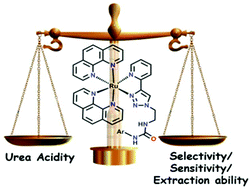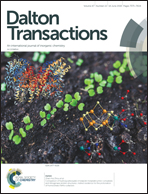Balancing the acidity of the pendant urea arm of bis-heteroleptic ruthenium(ii) complex containing pyridyl triazole for improved oxyanion recognition†
Abstract
Two new RuII-based bis-heteroleptic ditopic receptors 1[PF6]2 (C44H34F12N10OP2Ru) and 2[PF6]2 (C40H27F17N10OP2Ru), decorated with a 1-naphthyl and pentafluorophenyl urea pendant arm, respectively, along with the previously reported 3[PF6]2 (C40H31F13N10OP2Ru), containing a pendant 4-fluorophenyl urea unit and 4[PF6]2, devoid of a pendant urea arm, have been studied to establish the role of urea proton acidity on the sensing and extraction of oxyanions in the presence of triazole C–H as an additional hydrogen bonding motif. 1H-NMR, isothermal titration calorimetry (ITC) and photophysical experiments show selective binding of 1[PF6]2 and 2[PF6]2 toward oxyanions such as phosphates (e.g., H2PO4− and HP2O73−) and carboxylates (e.g., CH3CO2− and PhCO2−) like 3[PF6]2. This generalizes the role of triazole C–H and urea in the RuII-based bis-heteroleptic ditopic receptors towards recognition of such anions. Interestingly, complex 1[PF6]2 having intermediate acidic urea –NH protons showed the highest binding affinity with phosphates as compared to the other urea analogues 2[PF6]2 and 3[PF6]2 as well as the non-urea analogue, 4[PF6]2 (C32H24F12N8P2Ru). Moreover, 2[PF6]2 having the most acidic –NH protons showed higher binding affinity towards carboxylates as compared to that of 1[PF6]2/3[PF6]2. Detailed photo-physical studies revealed that 1[PF6]2 is a farsuperior and more selective H2PO4− sensor compared to 2[PF6]2/3[PF6]2/4[PF6]2, as evidenced by the higher degree of amplification of RuII center-based MLCT emission, greater change in excited state lifetime, lower detection limit and higher degree of selectivity. Furthermore, 1[PF6]2 also acts as a moderate liquid–liquid extraction agent of H2PO4−, CH3CO2− and PhCO2− anions, which was comparable to 3[PF6]2 and much higher as compared to 2[PF6]2/4[PF6]2.



 Please wait while we load your content...
Please wait while we load your content...